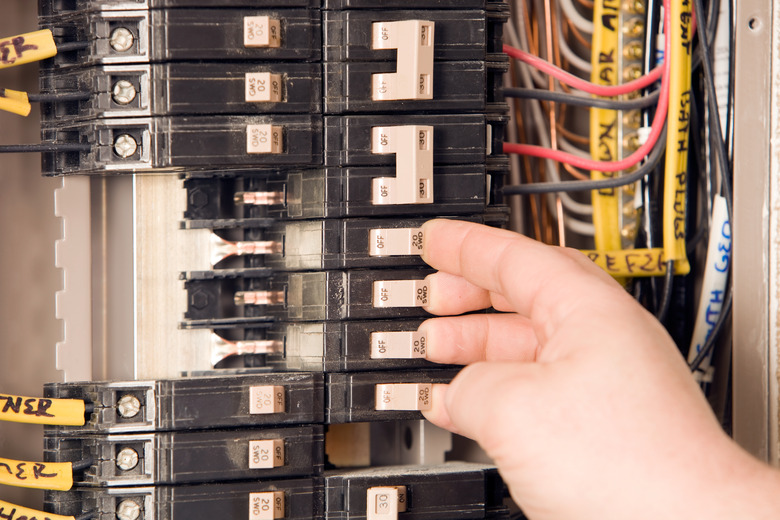How To Calculate Electrical Circuit Loads
We may receive a commission on purchases made from links.
If one of the circuit breakers in your panel keeps tripping, you're probably overloading the circuit, but what does that mean? The answer involves a little math, but don't worry if you have an aversion to that subject because the math is simple. It's based on the definition of electrical power, which is measured in watts, the unit the electric company uses to calculate your electrical bill.
Electrical power (P) circulating through an electrical circuit is the product of the current (I) and the voltage (V);
P = I x V.
Household circuits operate either at 120 or 240 volts (more or less), and most lights and household appliances are on 120-volt circuits, so there's one number for the equation already. Using it, you can calculate the load on a circuit either in units of power (watts) or current (amps), but since circuit breaker ratings are listed in amps, it's usually best to calculate load in terms of current.
Electrical Load of a Single Appliance
Electrical Load of a Single Appliance
When you plug in an appliance, the appliance motor, heating element or LED display connects to an electrical circuit that passes through a circuit breaker in the panel, and the appliance draws enough current from that circuit to make it work. The amount of current the appliance needs is the load it places on the circuit.
An appliance label doesn't always tell you the current draw; most of the time it tells you the power draw in watts. This is true of most appliances and light bulbs. To get a number that you can compare to the current rating of the breaker, you have to use the definition of power: P = IV, and here's where the math comes in. If you want to know the current, you have to rearrange the equation to read I = P/V so you can calculate I.
Suppose the label on a heater says it draws 1,500 watts. It's plugged into a standard receptacle, so the voltage is 120 volts. That means the electrical load it places on the circuit is 1500/120 = 12.5 amps of current.
Calculating Total Circuit Load
Calculating Total Circuit Load
To calculate the total electrical load on a circuit, you simply add the loads of all the individual light fixtures and appliances plugged into it that are working at the same time. For example, consider a circuit shared by four light fixtures and two receptacles. All the lights are on, you're operating a 1,500-watt space heater from one of the receptacles and you want to plug a 1,000-watt vacuum into the other one.
If the light fixtures all use 60-watt bulbs, they each draw 0.5 amps of current and taken together create a total load of 2 amps. Add the space heater, and the total electrical load is now 14.5 amps. Now plug in the vacuum, which draws 8.3 amps, and everything goes off the minute you turn it on. What happened? The vacuum added 8.3 amps to the total circuit load, which is now 22.8 amps, and that exceeded the current rating of the circuit breaker, which tripped to prevent a fire.
Circuit Breaker Overloads
Circuit Breaker Overloads
Circuit breakers for 120-volt circuits come with ratings of 10, 15 and 20 amps, which can be expressed as 1,200, 1,800 and 2,400 watts respectively. For safety, the electric code requires that each breaker trips if the current passing through it is 80 percent of its rating, so a 10-amp breaker will trip when the circuit load is 8 amps, a 15-amp breaker load limit is 12 amps and the limit for a 20-amp breaker is 16 amps.
If a breaker trips continually, you need to reduce the electrical load by unplugging appliances or turning off lights. You may be able to replace the breaker with one that has a higher rating, but only if the circuit is wired for it. An electrician can help you make that determination.
